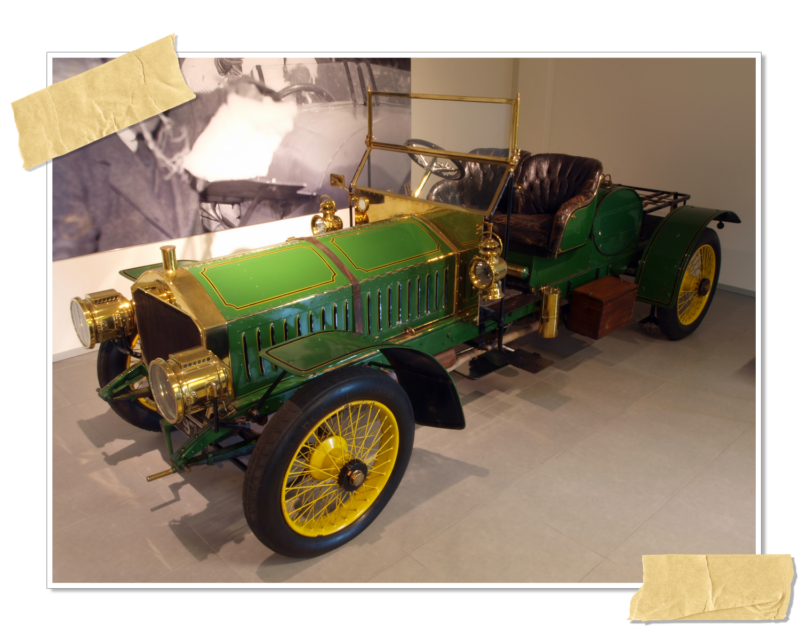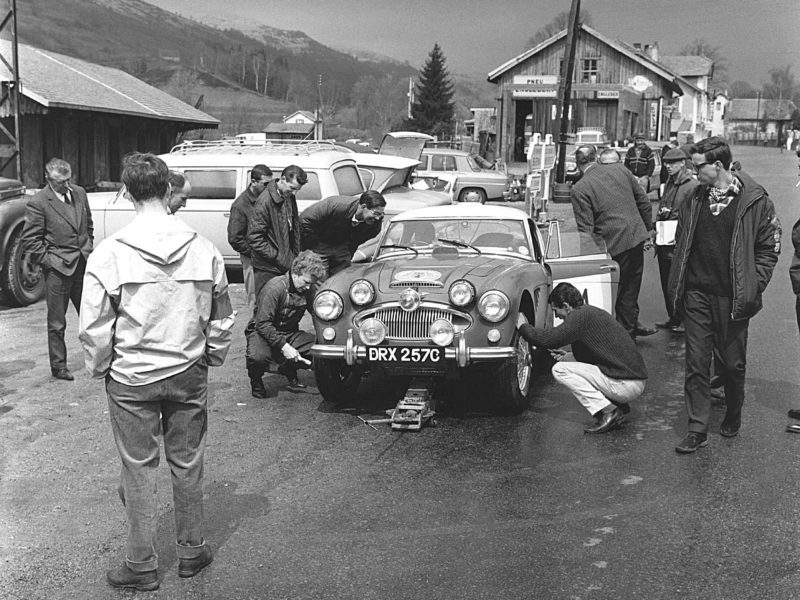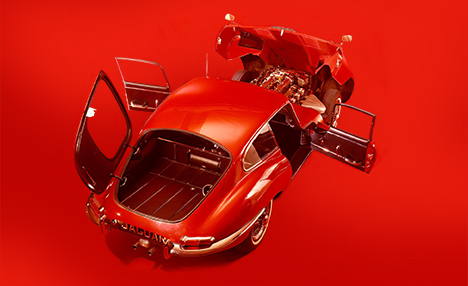by Amanda Lundquist
Despite being well-known in the classic car community, British Racing Green has a bit of an air of mystery to it. It’s immediately recognizable, and yet many colors bear its name, from the lighter GN. 25 to the deep, almost black tones seen on Jagaurs. There are often jokes on forums wishing people luck on the “search for British Racing Green”. Why does BRG encompass such a wide range of colors, why do enthusiasts have to hunt down the correct paint code for their restoration, and what does a color have to do with racing?
Here at Moss, we decided to do some digging. We scoured the online databases, turned over a few books, and even called a friend to see if we could make some sense of this famous color.
British Racing Green has long been associated with fast cars. The story is in 1903 when world powers like Britain, Germany, and France were looking to prove their engineering prowess, the United Kingdom was set to host that year’s Gordon Bennet Motor Cup. In years prior, Count Eliot Zborowski had suggested that each nation choose a color to represent themselves, making it easier for onlookers. With Germany taking white, France blue, and America red, Britain had chosen green as its national racing color. In fact, the winning Napier of the 1902 Cup had been painted olive.
Since they had won the previous year, the 1903 Cup was to be held in England, except that the English parliament had passed a law capping the speed limit to a crawling 12 mph with no exceptions. The UK decided to host the race in Ireland instead, where the law didn’t apply. To honor their new hosts, the UK team painted their cars in a bright shamrock or emerald green.

One of the earliest examples of British Racing Green.
Although British cars had been painted green in the past, it was this race that is credited for kicking off the tradition of British Racing Green.
As the years went on, deeper colors gained recognition and popularity. In 1929, British racecar driver William Grover-Williams won the inaugural Monaco Grand Prix in his green-painted Bugatti. While the Bennet Cup had tested a country’s engineering, the Grand Prix tested a driver’s skill, allowing drivers to race any car of their choosing. National racing colors became quite useful as racers drove cars that weren’t always manufactured in their countries. This win by Grover-Williams set the tone for some of the deeper shades of British Racing Green, with Bentleys and Jaguar cars following suit.
The lack of an official national shade allowed for a wide range of green to be used over the years, on the race track and outside of it. According to the article “The Color in Racing” from Road and Track’s 1960 issue, “British racing green, to dispel some of the arguments, is not any particular shade of green, but Napier green is preferred. Stirling Moss drove a light sea-green BRM in the 1959 French Grand Prix. This was quite contrary to the accepted general opinion of what constitutes “British Racing Green” but was, nevertheless, acceptable.” British manufacturers like MG, Healey, and Jaguar began to paint their cars in BRG. Since these companies participated in motorsports and often won famous races like Silverstone and Le Mans, it was a natural move to add the color to their offerings.
National racing colors were phased out in 1969, when Formula One relaxed their sponsorship regulations and allowed for race cars to sport their sponsors’ logos instead. By then, this tradition had been cemented in the minds of the public and street cars had been painted in British Racing Green for several decades; but again, since one official color of BRG was never picked – there was a lot of variety among manufacturers.
This is why get we such a wide range of colors, why MG had GN.25 and GN. 29. While a certain shade comes to mind, there are in reality many shades of BRG and they differ amongst makes and models.
There is another layer of complexity for the preservationists. Folks are right to narrow it down based on the year, make, and model of their vehicle but manufacturers, like MG, got paint from wherever they could, not a singular reliable source. As with many things with these cars, the word to use is “typically”, not “always” or “never”. Despite print advertisements and paint codes, colors were constantly fluctuating and could change mid-year if the factory happened to find a different or cheaper supplier.
There is one story that we heard, supposedly originating from a friend of Donald Healey, that one day, when the factory had run out of paint, they simply paid a visit to their local paint store, mixed up a batch as that was close enough to the original color, and used that to keep the line moving.
It was at this point in our research that we decided to reach out to a professional, Justin Jurgens at British Sports Cars in San Luis Obispo, to get his perspective on the matter. Having serviced and restored so many British classics, we figured he would have some insight.
Mr. Jurgens pointed out that it was simply a different mindset back then. Austin Healey had been known to use up old bonnets on their newer models to make sure the parts didn’t go to waste. Even back in the day, when Jaguar changed their name from Swallow Sidecar Company after World War 2, they didn’t bother recasting the engine blocks bearing the old company logo –but put them right into the production line along with the new ones. “They used what they could,” Justin said.
Bringing up his time judging at the Monterey Concours, he said that some folks come at British Cars with expectations that don’t always align with the “cheap and quick production” that they came from. Porche might have a certificate of authenticity from its methodical German manufacturers but with British cars, even with unrestored all-originals, “You see cars with parts from all over.” As he pointed out, even Ferrari Red was more standardized than British Racing Green.
So how would he define BRG? “Anything green,” Justin said, “typically a dark green with a bit of cream to it.”
The best way to get it “right”, according to him, was to color-match a sample of an original color. His go-to spots were under the dash or behind door cards, where the paint was protected from the sun, was more likely to survive previous restorations, and wasn’t subject to the heat and stress of the engine. Most places need a 3-inch square sample to color match properly. Even then the paint might have faded over time or oxidized, so he said he would usually swatch two shades darker and two shades lighter to give his customers a better idea of their options in case one suited the car or the vision better.
At the end of the day, he concluded, personal preference matters most.
Color-matching original preserved paint will give you one of the many shades that was called British Race Green but if that level of precision isn’t something you can manage – don’t be disheartened.
Many in the community have put together resources to help folks find the right color for their car. Looking at modern materials and paint systems, they have come up with very close approximations of original color codes for the different marques, models, and years.
After doing some research, we found these codes that we feel we can recommend:
MGB, British Racing Green Light:
1962-1963
Original Code: GN-25
PPG/Ditzler: 43342
Dupont: 8193
Sherwin Williams:9858

MGB, British Racing Green Dark:
1963-1970
Original Code: GN-29
PPG/Ditzler: 46446
Dupont: 9904
Sherwin Williams: 8194

Jaguar Early:
1955-1970
Original codes: ICI 2539, 5038
PPG/Ditzler: 43907
Dupont : 27265, 8542
Sherwin Williams : 8542, 6871

Jaguar Late:
1971-1979
Original codes: 8461, 254
PPG/Ditzler: 44524
Dupont: 32500
Sherwin Williams: 4131

Miata:
For a more modern take, try Miata’s interpretation of BRG –
formulated in honor of British Roadsters and their legacy.
1991-2001
Original code: HU
PPG/Ditzler: 47037
Dupont: L9563
RM/BASF: 20600
Glasurit: MAZ-648, MAZ648

Sufficed to say, from the start British Racing Green was more of an art than a science. The color started as a loose tradition to mark the country of origin, which created a legacy associated with speed and engineering prowess. As it went into production, it continued to morph over the years, changing from vehicle to vehicle. Now, despite being so recognizable, it still remains a bit elusive. Variety and variability have always been key components of BRG.
So, whether you color-match an original piece, hunt down a historical code, or simply go with the shade you like best, one could argue you are participating in and continuing on the rich tradition of British Racing Green.











'The History Of British Racing Green' have 5 comments
May 25, 2024 @ 5:33 pm Gerard P Houck
I have heard parts of this history before and I am sure there is “truth in them thar hills”. Adding to the history/story of the “national colors” of the worlds emerging automotive racing/industry, there was “red’ for Italy, “blue” for France, “white” for Germany, and The USA took “white w/two blue stripes”, and I think that Spain took “yellow”. Belgium took “mauve”, which was a little queer but then they woke up and painted their car in some rainbow colors, which didn’t make them go any faster but they were very loud. I love “BRG” but unfortunately my TR6 is “BRB”, (British racing brown). It’s not my favorite color but it is growing on me. Two of my friends have TR6’s which are “BRR” (British racing red). Whenever I go for a drive when the weather is “inclement” and the roads are “WRC” worthy, my TR comes out painted “BRM” (British racing mud). The bottom line is that whatever color your LBC came from the factory painted, or if it has been repainted, or if the color is so faded and worn that it could be called “BRV” (British racing vague), just keep the top down, stay on the twisty back roads, enjoy the HELL OUT OF IT and MOTOR ON BIG DOG!, MOTOR ON!
July 15, 2024 @ 8:50 am David Prado
It truly is, the color of champions.
December 9, 2024 @ 8:03 pm Dave Tucker
Thanks for your great site. I am hunting for a paint code for BRG that can be translated into 2024 paint mixes. This is a great discussion of BRG but I cannot use any of the info. I want to use BRG Dark as shown in the swatches and codes, but the same codes are shown for BRG light, so another dead end on matching with a BRG color code. Which one is it?
December 10, 2024 @ 8:35 am Chloe Gabriana
Hi Dave,
The correct paint codes for BRG Dark is as follows:
The Original Code: GN-25
PPG/Ditzler: 43342
Dupont: 8193
Sherwin Williams: 9858
May 21, 2025 @ 2:00 am Dagens Notiser : Gröna bilar som inte ser Gröna ut · Sir Pierre's Godispåse
[…] The History Of British Racing Green […]